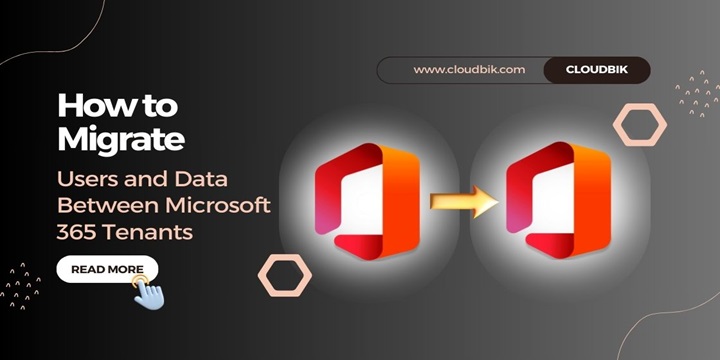How to Migrate Users and Data Between Microsoft 365 Tenants?

In today’s digital world, businesses using Microsoft 365 often undergo mergers, acquisitions, or restructuring that requires them to migrate users and data between Microsoft 365 tenants. Known as tenant to tenant migration, this process involves transferring users, emails, files, and other resources from one Microsoft 365 environment to another. While the migration may sound difficult and complex, following the right approach and leveraging the best cloud migration services can ensure a seamless transition. In this article, we’ll walk you through the process and share essential tips for a successful migration.
Understanding Tenant to Tenant Migration
Before walking into the migration steps, it’s important to understand what a tenant in Microsoft 365 refers to. A tenant is essentially your organization’s space in the cloud, with a unique domain, users, and resources. When you migrate between tenants, you’re moving these assets—such as user accounts, email data, OneDrive files, and SharePoint sites—from one organizational setup to another.
Why Perform Tenant to Tenant Migration?
Organizations may need tenant to tenant migration for various reasons, including:
- Company mergers and acquisitions: Combining multiple entities into a single Microsoft 365 environment.
- Rebranding or restructuring: Changing the organization’s domain and creating a new tenant for the business.
- Compliance needs: Moving sensitive data to a more secure tenant for regulatory compliance.
Regardless of the reason, it’s crucial to perform a migration without disrupting day-to-day operations. This is where proper planning and the right tools come in.
Step-by-Step Guide to Migrating Users and Data Between Microsoft 365 Tenants
Below are some points discussed that needs to be considered while performing the migration of data between Microsoft 365 Tenants
Plan the Migration
As with any large-scale project, proper planning is key. Begin by creating a pre-migration checklist that outlines everything you need to transfer. Some important factors to consider are:
- Total number of users
- Mailboxes, contacts, and calendar events
- OneDrive and SharePoint data
- Licensing requirements in the new tenant
Set a timeline for the migration and inform users of any downtime or changes they might experience during the process.
Assess User Data and Permissions
Evaluate the users and data you need to migrate. You’ll want to take stock of each user’s mailbox size, shared mailboxes, distribution lists, and associated permissions. Additionally, identify critical SharePoint sites and OneDrive files that need to be transferred.
A full understanding of the data will help you prioritize and plan your migration better, preventing any crucial data from being left behind.
Choose the Right Tools
Migrating users and data between Microsoft 365 tenants requires specialized tools. Microsoft provides native tools like PowerShell scripts for mailbox migration, but many businesses prefer third-party solutions that simplify the process. Companies such as CloudBik offer automated services for seamless tenant to tenant migration.
When selecting a tool, ensure it can handle large volumes of data and has built-in features to maintain security and compliance throughout the migration process.
Prepare Both Source and Target Tenants
Before migrating, ensure that both the source and target tenants are set up correctly. For example, make sure that the target tenant has enough licenses and resources to accommodate the incoming users and data. You’ll also need to configure DNS settings, set up domain names, and provision user accounts in the new tenant.
Begin the Migration
Once everything is set up, you can start migrating users and data. Migrations usually follow these steps:
- Mailbox migration: Use PowerShell scripts or third-party tools to transfer mailboxes, contacts, and calendars between tenants. During this process, users will experience minimal downtime. For native solution, check out this guide on tenant to tenant migration.
- OneDrive and SharePoint migration: Move user files from OneDrive and SharePoint to the new tenant. This can be time-consuming depending on the amount of data, so consider doing it in phases.
Post-Migration Testing and Verification
After the migration, thoroughly test all user accounts and data to ensure everything transferred successfully. Verify that users can access their mailboxes, OneDrive files, and SharePoint sites without any issues. It’s also essential to check that all permissions are intact.
Conclusion
Migrating users and data between Microsoft 365 tenants is a complex task that requires detailed planning and the right tools. By following the steps outlined in this guide and leveraging specialized cloud migration services, you can ensure a smooth tenant to tenant migration with minimal impact on business operations. A well-executed migration not only consolidates your Microsoft 365 resources but also enhances collaboration and security across your organization.




